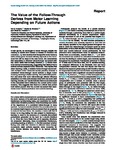The Value of the Follow-Through Derives from Motor Learning Depending on Future Actions
| dc.contributor.author | Howard, Ian | |
| dc.contributor.author | Wolpert, DM | |
| dc.contributor.author | Franklin, DW | |
| dc.date.accessioned | 2015-07-18T23:09:11Z | |
| dc.date.available | 2015-07-18T23:09:11Z | |
| dc.date.issued | 2015-02 | |
| dc.identifier.issn | 0960-9822 | |
| dc.identifier.issn | 1879-0445 | |
| dc.identifier.uri | http://hdl.handle.net/10026.1/3444 | |
| dc.description.abstract |
In ball sports, we are taught to follow through, despite the inability of events after contact or release to influence the outcome [1, 2]. Here we show that the specific motor memory active at any given moment critically depends on the movement that will be made in the near future. We demonstrate that associating a different follow-through movement with two motor skills that normally interfere [3-7] allows them to be learned simultaneously, suggesting that distinct future actions activate separate motor memories. This implies that when learning a skill, a variable follow-through would activate multiple motor memories across practice, whereas a consistent follow-through would activate a single motor memory, resulting in faster learning. We confirm this prediction and show that such follow-through effects influence adaptation over time periods associated with real-world skill learning. Overall, our results indicate that movements made in the immediate future influence the current active motor memory. This suggests that there is a critical time period both before [8] and after the current movement that determines motor memory activation and controls learning. | |
| dc.format.extent | 397-401 | |
| dc.format.medium | Print-Electronic | |
| dc.language | en | |
| dc.language.iso | eng | |
| dc.publisher | Elsevier BV | |
| dc.subject | Analysis of Variance | |
| dc.subject | Association Learning | |
| dc.subject | Games, Experimental | |
| dc.subject | Humans | |
| dc.subject | Models, Psychological | |
| dc.subject | Motor Skills | |
| dc.subject | Psychomotor Performance | |
| dc.subject | Time Factors | |
| dc.title | The Value of the Follow-Through Derives from Motor Learning Depending on Future Actions | |
| dc.type | journal-article | |
| dc.type | Journal Article | |
| dc.type | Research Support, Non-U.S. Gov't | |
| plymouth.author-url | https://www.webofscience.com/api/gateway?GWVersion=2&SrcApp=PARTNER_APP&SrcAuth=LinksAMR&KeyUT=WOS:000348967000030&DestLinkType=FullRecord&DestApp=ALL_WOS&UsrCustomerID=11bb513d99f797142bcfeffcc58ea008 | |
| plymouth.issue | 3 | |
| plymouth.volume | 25 | |
| plymouth.publication-status | Published | |
| plymouth.journal | Current Biology | |
| dc.identifier.doi | 10.1016/j.cub.2014.12.037 | |
| plymouth.organisational-group | /Plymouth | |
| plymouth.organisational-group | /Plymouth/Faculty of Science and Engineering | |
| plymouth.organisational-group | /Plymouth/Faculty of Science and Engineering/School of Engineering, Computing and Mathematics | |
| plymouth.organisational-group | /Plymouth/REF 2021 Researchers by UoA | |
| plymouth.organisational-group | /Plymouth/REF 2021 Researchers by UoA/UoA11 Computer Science and Informatics | |
| plymouth.organisational-group | /Plymouth/Users by role | |
| plymouth.organisational-group | /Plymouth/Users by role/Academics | |
| dc.publisher.place | England | |
| dcterms.dateAccepted | 2014-12-15 | |
| dc.identifier.eissn | 1879-0445 | |
| dc.rights.embargoperiod | Not known | |
| rioxxterms.versionofrecord | 10.1016/j.cub.2014.12.037 | |
| rioxxterms.licenseref.uri | http://www.rioxx.net/licenses/all-rights-reserved | |
| rioxxterms.licenseref.startdate | 2015-02-02 | |
| rioxxterms.type | Journal Article/Review |


